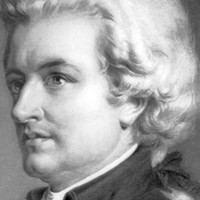Chamber Music Series: Mendelssohn’s Octet for Strings



Mozart’s delightful Divertimento in D Major, K. 136, belongs to a seemingly inconsequential literature. In the late eighteenth century, divertimentos, serenades, and other incidental genres—musical greetings cards, typically intended for outdoor celebrations—were penned quickly as the occasion arose, and rarely with the expectation of a second performance. Mozart seems to have used the terms divertimento (meaning simply a “piece for enjoyment”) and serenade (designating a piece to be played in the evening) more or less interchangeably. But while these pieces aspired neither to profundity nor to posterity, in the hands of such a creative genius as Mozart, even a genre approached so casually could be a vessel for exquisite music.
The present Divertimento is the first of a set of three that Mozart composed in early 1772, while just sixteen years old. The work comprises three movements. The vivacious Allegro first movement demonstrates an astute conversational quality among individual parts that would likewise characterize Mozart’s mature chamber music. The Andante does less to contrast than the Allegro’s exuberance than to complement it with a gentle elegance. The work ends with a buoyant Presto finale.
All of the most cherished musical values of the Classical period are given their most perfect voice by Mozart, whether in his most majestic symphonic and operatic creations or in such seeming bagatelles this Divertimento. Viennese Classicism valued the primacy of melody; Mozart’s melodies are poetic, expressive, uncannily beautiful. His rich harmonies and instrumental textures, both on full display throughout this work, are equally seductive. And as Classicism moved away from the complexity of Bach’s fugues towards more transparent forms, the effortlessness of Mozart’s music belies its formal sophistication. In the characteristic balance of expressive beauty and formal elegance of his music—to be found without fail throughout his entire oeuvre, and which is perhaps even more striking in such trifles as his Divertimenti, when it seems like he’s hardly even trying—we find the quintessence of Mozart’s craft.
Patrick Castillo ©2016
The most significant Danish musical figure of his generation, composer Carl Nielsen moreover reflects Western music’s evolving zeitgeist at the turn of the twentieth century. Rooted in a Brahmsian strain of Romanticism, his oeuvre would come to encompass a broad stylistic spectrum, including a distinctive take on the neoclassicism of Stravinsky and Prokofiev. His Wind Quintet, Opus 43, composed in 1922, illustrates this latter facet of Nielsen’s art. Inspired by a performance by members of the Copenhagen Wind Quintet of Mozart’s Sinfonia concertante in E-flat, K. 297b, Nielsen endeavored to compose a quintet for the ensemble, as well as concerti for each player. He completed a Clarinet Concerto and a Flute Concerto, which, like the Quintet, endure among the most significant twentieth-century works in their respective genres.
The Quintet indeed betrays the influence of Mozart, demonstrating the most cherished characteristics of that composer’s own music: its melodic beauty, formal elegance, delicate textures—but all filtered through a distinctly au courant sensibility. This straddling of old-world influence and modernity is apparent from the work’s first breath, as the bassoon presents the first theme, outlining an E major scale—quickly arriving at an alien F-natural. This puckish chromaticism opens a window for the rest of the ensemble to enter. Here and throughout, Nielsen integrates the five winds’ individual timbres with a light touch, retaining a featherweight transparency even when doubling and tripling instruments.
Nielsen himself provided the following note to his Opus 43: “The quintet for winds is one of the composer’s latest works, in which he has attempted to render the characters of the various instruments. At one moment they are all talking at once, at another they are quite alone. The work consists of three movements: a) Allegro, b) Minuet and c) Prelude – Theme with Variations. The theme for these variations is the melody for one of C.N.’s spiritual songs—his hymn tune My Jesus, Make My Heart to Love Thee—which has here been made the basis of a set of variations, now merry and quirky, now elegiac and serious, ending with the theme in all its simplicity and very quietly expressed.”
Patrick Castillo ©2016

Strum is the culminating result of several versions of a string quintet I wrote in 2006. It was originally written for the Providence String Quartet and guests of Community MusicWorks Players, then arranged for string quartet in 2008 with several small revisions. In 2012 the piece underwent its final revisions with a rewrite of both the introduction and the ending for the Catalyst Quartet in a performance celebrating the 15th annual Sphinx Competition.
Originally conceived for the formation of a cello quintet, the voicing is often spread wide over the ensemble, giving the music an expansive quality of sound. Within Strum I utilized texture motives, layers of rhythmic or harmonic ostinati that string together to form a bed of sound for melodies to weave in and out. The strumming pizzicato serves as a texture motive and the primary driving rhythmic underpinning of the piece. Drawing on American folk idioms and the spirit of dance and movement, the piece has a kind of narrative that begins with fleeting nostalgia and transforms into ecstatic celebration.
Jessie Montgomery ©

Mendelssohn’s reputation as Western music’s greatest prodigy could rest on the magnificent Opus 20 Octet alone, for it far exceeds any accomplishment of Mozart, Schubert, or any other wunderkind by the age of sixteen. But more than an impressive show of precocity, the Octet is bona fide masterpiece irrespective of the composer’s age.
Throughout the work, Mendelssohn displays an uncanny mastery of sonority, exploring the various textures afforded by the ensemble at hand. Witness its unforgettable opening, first violin soaring above expectant tremolandi. A crooning duet between fourth violin and first viola introduces the lyrical second theme. As Mendelssohn develops this idea, the first violin continues to comment with fragments of its cavalier opening melody. The movement’s development section is rife with Beethovenian Sturm und Drang; tentative syncopations build to an exhilarating crest, as all eight parts come together in a fortissimo sixteenth-note run to the recapitulation.
The thoughtful Andante provides a foil for the first movement’s forward thrust. Without losing anything of the ensemble’s expres¬sive capacity, Mendelssohn pares down the octet texture to achieve heartrending subtlety and delicacy.
From the composer’s sister Fanny Mendelssohn, we have insight into the creative impetus behind the fleet scherzo. Fanny writes that Felix “set to music the stanza from Walpurgis Night’s Dream in [Goethe’s] Faust:
The flight of the clouds and the veil of mist Are lighted from above. A breeze in the leaves, a wind in the reeds, And all has vanished.
To me alone he told this idea: the whole piece is to be played stac¬cato and pianissimo with shivering tremolos and lightning flashes of trills. All is new, strange, and yet so familiar and pleasing—one feels so close to the world of spirits, lightly carried up into the air. Indeed one might take a broomstick so as to follow the airy procession. At the end the first violin soars feather-light aloft—all is blown away.”
An arresting fugue launches the Presto finale. But just as Mendelssohn’s deft counterpoint and fugal technique suggest his deep study of Bach, so does the symphonic breadth of the Octet’s finale reveal the influence of Beethoven. For¬tissimo octaves across the full ensemble punctuate the opening fugato, emitting a caffeinated energy that continues unrelenting for the remainder of the work. Near the end, Mendelssohn reintroduces the scherzo melody, transport¬ing the listener back to the enchanted world of the third movement before bringing the magnificent Octet to its thrilling conclusion.
Patrick Castillo ©2016
Get driving directions and find nearby parking.
Find dining options close to the venue.
View seating charts to find out where you'll be seating.
SPCO concerts are made possible by audience contributions.
For exclusive discounts, behind-the-scenes info, and more:
Sign up for our email club!
